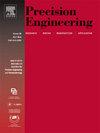Sequential identification of joint-dependent geometric errors for industrial robots using a laser tracker
IF 3.5
2区 工程技术
Q2 ENGINEERING, MANUFACTURING
Precision Engineering-Journal of the International Societies for Precision Engineering and Nanotechnology
Pub Date : 2025-04-17
DOI:10.1016/j.precisioneng.2025.04.014
引用次数: 0
Abstract
Industrial robots are vital in modern industrial automation, yet limited absolute positioning accuracy constrains their broader applications in precision manufacturing. To improve both absolute positioning accuracy and task reliability, robot error identification and compensation are essential steps. This study investigates the calibration of joint-dependent geometric errors to enhance the absolute positioning accuracy of industrial robots. The robotic kinematic model considering the 36 joint-dependent geometric errors is firstly modeled. Based on this model, an innovative approach is proposed to isolate and sequentially identify joint-dependent geometric errors through joint-wise motion data. By systematically separating and quantifying these errors, the method allows for precise identification and compensation of joint-dependent geometric errors, thereby enhancing the absolute positioning accuracy of the robot. Experimental results show that the proposed method can substantially improve the absolute positioning accuracy of industrial robots. The proposed model accounts for approximately 78 % of absolute positioning errors, outperforming the classical DH model by 17 %, thereby demonstrating its superior effectiveness in controlling absolute positioning errors.
使用激光跟踪器顺序识别工业机器人的关节几何误差
工业机器人是现代工业自动化的重要组成部分,但有限的绝对定位精度限制了其在精密制造领域的广泛应用。为了提高绝对定位精度和任务可靠性,机器人误差识别和补偿是必不可少的步骤。为了提高工业机器人的绝对定位精度,研究了关节相关几何误差的标定方法。首先建立了考虑36个关节相关几何误差的机器人运动学模型。在此基础上,提出了一种利用关节相关运动数据分离和序列识别关节相关几何误差的创新方法。通过系统地分离和量化这些误差,该方法可以精确识别和补偿关节相关的几何误差,从而提高机器人的绝对定位精度。实验结果表明,该方法能显著提高工业机器人的绝对定位精度。该模型约占绝对定位误差的78%,比经典DH模型高出17%,表明了其在控制绝对定位误差方面的优越性。
本文章由计算机程序翻译,如有差异,请以英文原文为准。
求助全文
约1分钟内获得全文
求助全文
来源期刊
CiteScore
7.40
自引率
5.60%
发文量
177
审稿时长
46 days
期刊介绍:
Precision Engineering - Journal of the International Societies for Precision Engineering and Nanotechnology is devoted to the multidisciplinary study and practice of high accuracy engineering, metrology, and manufacturing. The journal takes an integrated approach to all subjects related to research, design, manufacture, performance validation, and application of high precision machines, instruments, and components, including fundamental and applied research and development in manufacturing processes, fabrication technology, and advanced measurement science. The scope includes precision-engineered systems and supporting metrology over the full range of length scales, from atom-based nanotechnology and advanced lithographic technology to large-scale systems, including optical and radio telescopes and macrometrology.

 求助内容:
求助内容: 应助结果提醒方式:
应助结果提醒方式:


